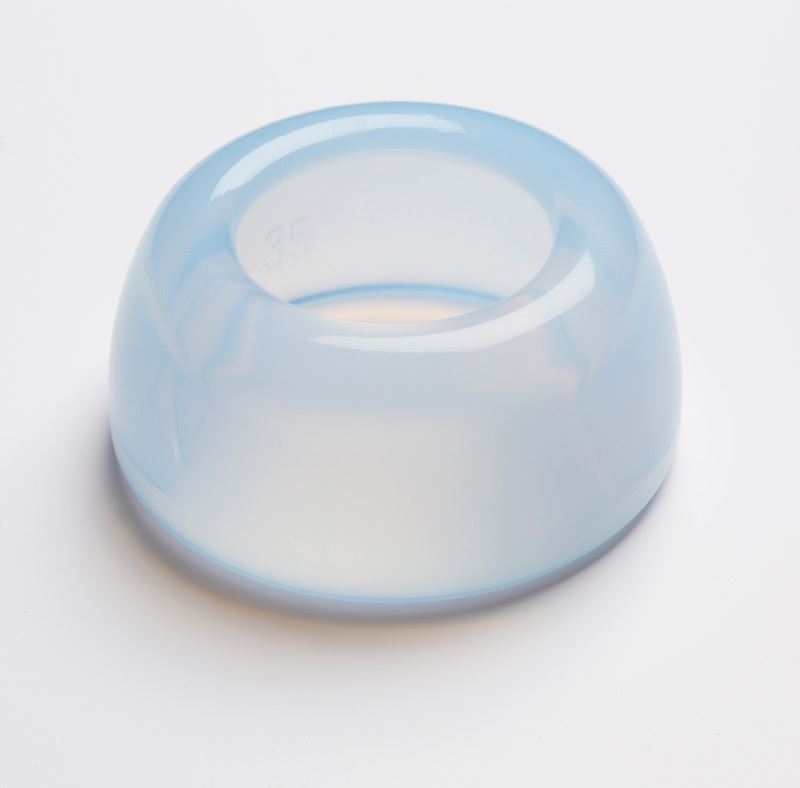
To support the cervix in pregnant patients either with complaints of prolapse (painful “downward pressure“ during standing and walking) and pregnant women exposed to physical strain (e.g. standing for a long time) and / or in patients with threatening preterm labor (funneling / short cervical length).
The cerclage pessary consists of high-quality silicone. It can be stored at temperatures from 1 to 30 °C protected from UV radiation without contact to reactive media, gas, ozone or mineral oil.
Since the introduction of the device the material and the consistency of the product have been stepwise improved. Since 2020, objective compression values have been standardized related to the indication (Model 3).
The pessary consists of flexible comfortable silicone. Like all silicone pessaries it is elastic, it can be folded and thus be inserted without pain. The cervical pessary is designed for the treatment of pregnant women, to support the cervix mainly in patients with additional complaints of prolapse (painful “downwards” pressure during standing and walking), pregnant women who are exposed to physical strain (e.g. standing for a long time), increased intrauterine pressure, e.g. multiple pregnancies or ultrasound signs of an incompetent cervix.
Before insertion, bacterial swabs can be performed to exclude bacterial colonization (no absolute indication). The pessary treatment should start before the cervix might be effaced at an early stage of cervical shortening diagnosed by transvaginal sonography. In patients with U-shaped funnelling a wider upper diameter (35 mm) might prevent unnecessary prostaglandin release. The pessary is not meant to close the cervix completely but rather to support it and to shift the cervix towards the sacrum.
In case of increased cervical/vaginal discharge perforated pessaries allow a better passage of fluids. It could be demonstrated by randomized trials that increased discharge is not associated with a change of the vaginal microbiome and not with an increased risk of “infection” or chorioamnionitis. Therefore, it is not an indication for routine administration of antibiotics nor for removal.
The cervical pessary is inserted in a lithotomy position by the obstetrician. It is vital that the curvature of the pessary shows upwards so that the larger diameter is supported by the pelvic floor. The pessary can be folded and then be placed into the vaginal fornix. Thereby the cervix should be located within the upper ring diameter. The obstetrician may control if the cervix is not surrounded too firmly. After the insertion the patient is asked to get up. Normally patients indicate “relief of prolapse complaints” immediately after placement.
The insertion of the pessary can be facilitated by spreading a gliding compound or a fluid.
Before removal, the cervix should be carefully pushed back before pulling. If a pessary is “stuck” due to edema or contractions it is better to cut the whole silicone ring (e.g. with scissors used for episiotomy) instead of violently pulling and risking cervical lesions. In any case of bleeding or painful contractions a speculum examination should be performed.
Under normal conditions, the pessary should be removed at around 37 weeks in asymptomatic patients. In cases of blood loss it may be changed and cleaned in between, but in general, manipulations are better avoided. In all patients with premature rupture of membranes and signs of chorioamnionitis, vaginal blood loss and severe painful contractions the pessary should be removed to avoid cervical lesions or ascending infection.
Transvaginal sonographic examinations help to identify the cervical shape and length but the visualization of transvaginal sonography may be impaired by the pessary and the transducer better has to be directed best on the anterior or towards the posterior part of the pessary. The position of the pessary can easily be controlled manually during routine controls.
In patients with a scheduled Cesarean the pessary can be removed in the operation theatre before the skin incision.
Side Effects/Complications:The position of the pessary (with the curvature and the smaller diameter upwards and some angulation) is the key in the success of treatment. There might be some increase of abacterial discharge. However, the composition of the vaginal flora will not be substantially altered.
| Cerclage-Sizes | 65/17/32 mm, 65/17/35 mm, 65/21/32 mm, 65/21/35 mm, 65/25/32 mm, 65/25/35 mm, 65/30/35 mm, 70/17/32 mm, 70/17/35 mm, 70/21/32 mm, 70/21/35 mm, 70/25/32 mm, 70/25/35 mm |
|---|

Meyona provides high quality products, along with proffesional consultancy, reliable technical support and excellent service for some of the most reputable hospitals, clinics and IVF centers in Bulgaria, Macedonia and Kosovo.